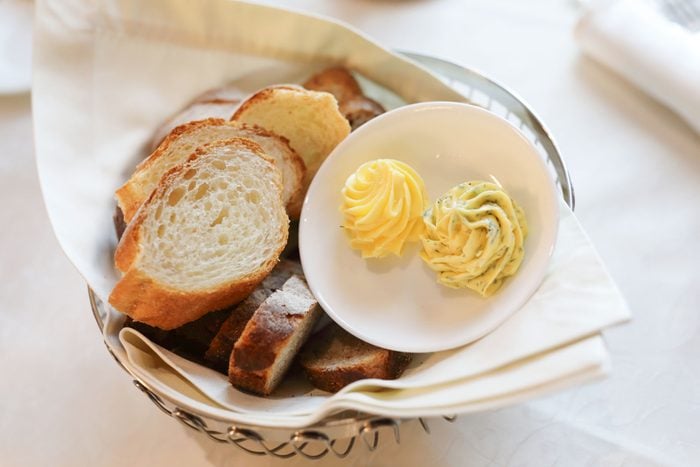Here’s Why Butter Always Tastes Better at Restaurants
Updated: Aug. 28, 2023

They say that everything’s better with butter, and it’s hard not to agree. The best-tasting butter can make just about anything sing. Think about what a pat or two of butter can do for bland, starchy foods like rice, noodles and potatoes. You might not ordinarily think of eating an entire basket of bread, but serve it alongside a bowl of restaurant butter and it becomes downright irresistible. Such is the power of butter.
But do you need to visit your favorite restaurant to enjoy the best butter of your life? Nope! Yes, professional chefs know a few butter hacks—including how to refrigerate it properly—but you can easily learn them. And lucky for you, we’re about to reveal all those tricks. Here are the secrets behind restaurant butter, along with a few helpful food facts, so you can taste the magic anytime you please.
Get Reader’s Digest’s Read Up newsletter for more food tips, humor, cleaning, travel, tech and fun facts all week long.
Why does restaurant butter taste better?
Let’s get one thing straight: The notion of “better” is entirely subjective, so there are many different reasons someone might believe restaurant butter tastes better than what they’re eating at home. Not only that, but all restaurants serve different brands and styles of butter! A fast-service restaurant like a diner may serve prepackaged pats of ice-cold butter. A farm-to-table bistro might make its own butter for smearing on house-made bread, while a steakhouse may serve softened compound butters for melting on sizzling-hot steaks. Here are a few different reasons your favorite restaurant butter might stand out from the rest.
It’s brimming with butterfat
“I think restaurant butter often tastes better because it has a higher butterfat percentage,” says Luke Ilardo, head baker and owner of Doppio Pasticceria in Baltimore. “Most grocery stores offer 80% butterfat, but through our distributors, we can pretty easily find up to 86% butterfat. The higher butterfat will lend to a richer butter.”
Chefs don’t skimp on the seasoning
When butter is being served as a key part of a main dish, like smeared on artisanal toast or melted into a pool for dipping lobster, chefs treat it as an ingredient—not an afterthought. Butter isn’t left alone; it’s tasted and seasoned so that it perfectly complements everything else on the plate. And the most common seasoning to make restaurant butter taste better shouldn’t come as much of a surprise.
“Proper salt levels make everything taste better,” says Ilardo. “Depending on whether a dish is sweet or savory, salt can enhance desirable tasting notes while minimizing others. [The key is] the amount of salt used. So, for a butter-heavy dish, like brioche col tuppo, we use a high-butterfat butter and proper levels of salt.”
It’s used up quicker
Butter is little more than a big block of fat, and fats are excellent at absorbing odors. If unwrapped or partially wrapped butter sits in your fridge long enough, it will begin to taste like whatever it is your fridge smells like—and even if your fridge is immaculate, that’s not good. In restaurants, however, unwrapped butter rarely lasts for long, and the odds of it sticking around long enough to pick up odd refrigerator odors are slim.
How can you get restaurant-style butter at home?
You shouldn’t need to go to a restaurant to enjoy high-quality butter whenever you’ve got a craving—and you don’t have to. Try these tips to get restaurant-style butter at home.
Buy the good stuff
Standard supermarket butter is fine for when you’re cooking or baking, but if you’re buying butter to slather on toast or toss with piping-hot noodles, spend a little extra money and treat yourself to something nice. Butters with a higher fat content taste more luscious, while grass-fed butters have a richer, more complex flavor. They may cost a little more than regular butter, but trust us, they’re worth it.
“High-butterfat butters are typically marketed as ‘European style’ and can often come in a large log or roll, as opposed to half-cup sticks,” says Ilardo. “Also, many farmers-market dairy vendors will offer butter, and buying directly from the producer—particularly a small-scale, market-oriented producer—is a great way to ensure quality.”
Keep your butter on the counter
For long-term storage, keeping your butter in the fridge or freezer is best. But if you’re planning to smear it on bread, waffles or whatever else tickles your fancy, let it sit out for a while till it comes to room temperature. As long as your kitchen is at a comfortable temperature, leaving your butter out on the counter for at least 20 minutes will make it perfectly spreadable.
You can leave any remaining butter out on the counter for another day or two, as long as you think you’ll use it up. Otherwise, put it back in the fridge, since butter left out for more than two days can begin developing off flavors. If you’re storing your butter outside your fridge, opt for salted butter, since salt makes the butter inhospitable to bacteria. Of course, you should also pay strict attention to butter expiration dates.
Add some flavor
Wish you could enjoy fancy flavored butters at home? You can—all you need is a mixer! Using a stand or handheld mixer, whip softened, unsalted butter on medium speed till it’s broken up, then add the flavorings of your choice. There’s no real formula here, so feel free to experiment. Try drizzling in a bit of maple syrup with a pinch of pumpkin-pie spices to taste, a mess of chopped fresh herbs, or some softened, crumbly cheese, like blue cheese or chèvre.
Whip it good
If the restaurant butter you love is light and fluffy, it’s because it’s been whipped. And it’s super easy to do. Simply beat slightly softened butter (leave it on the counter for about 10 minutes or so) on medium speed, which will incorporate thousands of tiny air bubbles that will make your butter spectacularly spreadable. You can do this with either salted or unsalted butter, but if you use the latter, give it a taste before serving. You might want to whip in a pinch or two of high-quality salt (like sea salt) to punch up the flavor.
Whipped butter should be stored in the fridge in an airtight container. Do this, and it will actually stay good for months.
About the expert
- Luke Ilardo is the chef and owner of Doppio Pasticceria in Baltimore, specializing in Sicilian-style baked goods made from hyperlocal ingredients. Sourcing nearly all his ingredients from the greater Chesapeake region, Ilardo takes the meaning of “from scratch” baking to heart, milling his own grains for breads and making his own cheeses with milk from local dairies.



